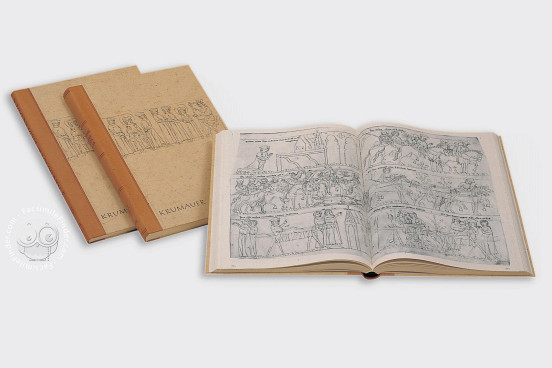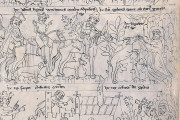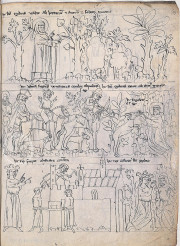Dating from the middle of the fourteenth century, the Krumlov Picture Codex is one of the largest and most pictorially complex records of Christian saints' lives. The manuscript illustrates the lives of many saints directly important to Bohemian royalty and was thus probably made for a patron with a particular passion for regional saints. Its more than 300 pages are occupied almost entirely by drawings on Christian themes.
The manuscript contains the Biblia pauperum ("Bible of the Poor"), two moralistic parables, and a collection of thirty legends.
A Restrained Palette
The codex is entirely composed of images. The lack of color is a striking and unusual element in light of the manuscript's pervasive imagery. Apart from the sparse red tituli found at the beginning of the book, there are no traces of color beyond the brown ink of the drawings. It is difficult to determine whether the book is finished.
Captions relating to the figures and scenes are written in and atop the pictures. These inscriptions show several scribes at work, and the quality of the writing varies greatly.
Unbroken Edifying Images
Running left-to-right and top-to-bottom, each group of scenes is arranged in a sequence that extends across facing pages of the open book. The first pages (fols. 1-28) contain typological pairings of Old and New Testament scenes in two registers. The remainder of the book arranges its images in two or three registers that similarly run across the openings.
The Krumlov Picture Codex makes a bold visual argument for the importance of Bohemian saints. The saints whose legends are highlighted include local and relatively recent saints and flow directly into the legends of early saints and martyrs. For example, the lives of the tenth-century historical Wenceslas and his grandmother Ludmilla are pictured near that of the legendary early Christian Christopher.
A Royal Manuscript?
The origins of the Krumlov Picture Codex are contested in modern scholarship. The nineteenth-century term "Bible of the Poor" is misleading. The genre of picture book that opens the manuscript was popular with laypeople and members of the clergy, and the owners of these trendy books were mostly literate and wealthy.
The manuscript may be unfinished, and it lacks any overt signs of patronage, date, or authorship. Scholars have speculated that the manuscript may have been made by and for the use of the Minorite (Franciscan) nuns of Český Krumlov in southern Bohemia.
It has also been argued that Anna Svídnická (1339–1362), the third wife of Holy Roman Emperor Charles IV, was the likely patron. The Bohemian saints included can be directly tied to her lineage and the consecration of the Český Krumlov cloister. Indeed, the cloister's consecration may have been the occasion of the commission of a luxurious manuscript to honor the queen and her lineage.
Given the similar subject (saintly ancestors) and style (illustrations in registers with captions), the Krumlov Picture Codex—if commissioned by Anna Svídnická—could be understood as a corollary to the Hedwig Codex. Both manuscripts promote the sacred ancestry of the Piast dynasty.
From the Monastery to Vienna
The codex was at the Minorite Monastery in Český Krumlov by the eighteenth century. Joseph II (1741-1790), Holy Roman Emperor, abolished the monasteries, and the book was transferred to Vienna.
We have 1 facsimile edition of the manuscript "Krumlov Picture Codex": Der Krumauer Bildercodex facsimile edition, published by Akademische Druck- u. Verlagsanstalt (ADEVA), 1967
Request Info / Price


